 |
 |
 |
| |
Mortality among adult PLHIV in all PEPFAR-supported
countries and regions-, October 2019-June 2022
|
| |
| |

Aging Workshop Oct 14-15 2022
Elfriede Agyemang, MD, MPH1, Deborah Goldstein, MD2, Danielle Fernandez, MPH1, Brooke Doman, MPH1, Kiva Fisher, PhD1, Neha Shah, MD, MPH3, Erin Whitehouse, PhD1, Nickolas Agathis, MD, MPH1, Hammad Ali, MBBS, MPH, PhD1, Iyiola Faturiyele, MD, MPH2, George Siberry, MD, MPH2, Catherine Godfrey, MD4
1U.S. Centers for Disease Control and Prevention (CDC), Atlanta, GA; 2United States Agency for International Development, Washington, D.C.; 3 U.S. Military HIV Research Program, Walter Reed Army Institute of Research, Silver Spring, MD; 4Office of the Global AIDS Coordinator, U.S. Department of State, Washington, D.C.
Abstract
Background: As many countries in low and middle-income countries reach HIV epidemic control, there is a growing population of adults in treatment who are older than 50 years. Resources and interventions need to be focused on improving life expectancy and quality of life in this cohort of People Living with HIV (PLHIV). In 2019, the U.S. Presidbegan collecting mortality data for PLHIV receiving antiretroviral (ARV) treatment (ART) that are lost to follow-up, in PEPFAR-supported programs. We reviewed mortality trends in PLHIV ages 50+ years on ART and assessed the impact of viral load coverage (VLC), viral suppression (VLS), and interruptions in treatment (IIT) on mortality.
Material and Methods: PEPFAR-supported programs submit aggregate data quarterly using standardized indicators disaggregated by age and sex. Relevant indicators, including TX_ML (captures information on interruptions in treatment and mortality), VLC, and VLS (HIV RNA <1000 copies/mL) were analyzed to assess deaths reported for all 15-49 and 50+ year old PLHIV on ART from October 2019 to September 2021 for PEPFAR-supported countries and regions (n=28). VLC was calculated quarterly as number of PLHIV on ART with a VL result documented in the medical or laboratory records within the past 12 months divided by the number of PLHIV on ART from 6 months prior. Proportion died was calculated quarterly as number of reported deaths in the current reporting quarter divided by the sum of the number of PLHIV on ART in the previous reporting quarter and the number of PLHIV newly initiated on ART in the current reporting quarter. We defined %IIT as proportion of PLHIV on ART that had no clinical visit or ARV pick up for at least 28 days after the last scheduled appointment, and are not known to have died, stopped treatment, or transferred to another facility.
Results: The median proportion died across all countries quarterly was 0.22% (range: 0.18-0.26) and was higher in the 50+ age group compared to the 15-49 group (0.34%; range: 0.29-0.44 versus 0.18%; range: 0.17-0.22). Among the 50+ group, the median proportion died was higher among men than women (0.42%; range: 0.37-0.55; versus 0.27%; range: 0.23-0.36). Over the same period, the median VLC and VLS were greater among 50+ group (VLC: 83.0%; range: 82-83; VLS 95.5%; range: 94-97) than among 15-49 group (VLC 74.8%; range: 73-77; VLS 92.6%; range: 91-95). Median %IIT was lower in the 50+ group (2.1%; range: 1.8-2.8) compared to 15-49 group (3.4%; range: 2.8-4.2). Among the 50+ group, median %IIT was higher among men than women (2.3%; range: 2.0-2.8 versus 2.0%; range: 1.6-2.7).
Conclusions: PLHIV are reaching older ages with lifesaving ART and those 50+ years have high VLC, high VLS, and low %IIT in PEPFAR-supported countries. Some of these deaths among the 50+ group may be expected due to the aging cohort. However, reducing mortality may require investigation beyond these HIV-associated factors, focusing on other modifiable causes of death such as COVID-19, comorbid noncommunicable diseases, and advanced HIV disease to inform future PEPFAR program resource allocation.
This abstract was made possible by the support of the U.S. President's Emergency Plan for AIDS Relief (PEPFAR). The findings and conclusions in this abstract are those of the author(s) and do not necessarily represent the official position of the funding agencies or the agencies that the authors represent.
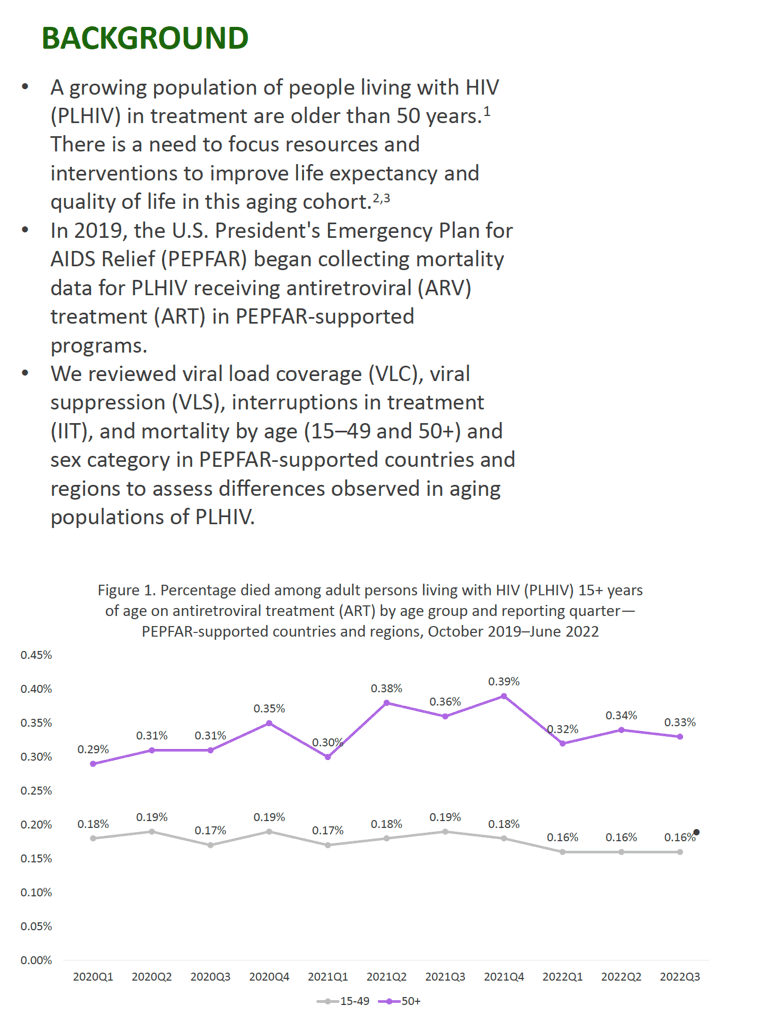
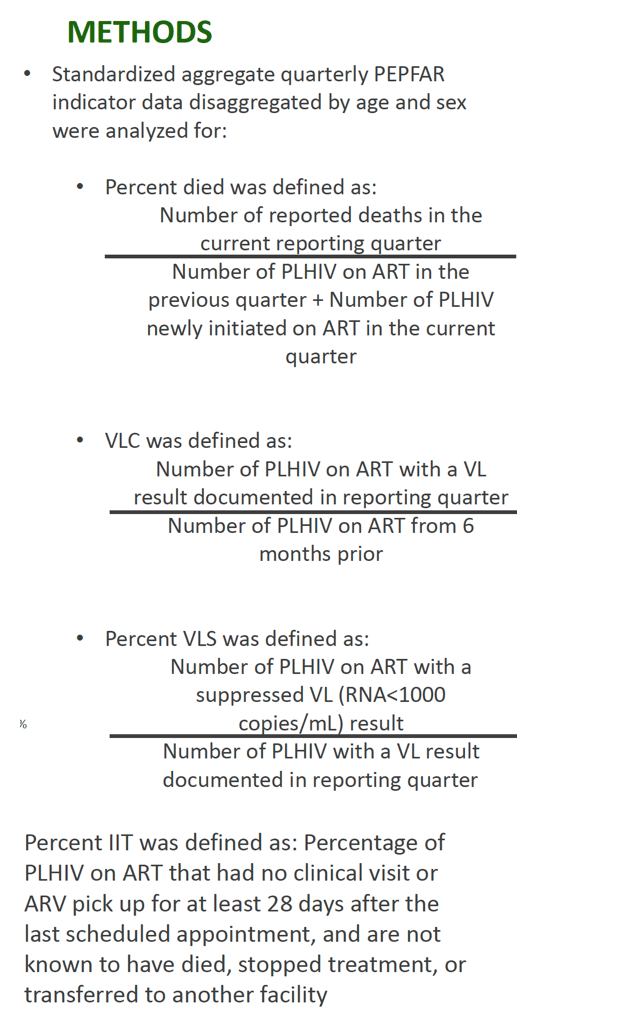
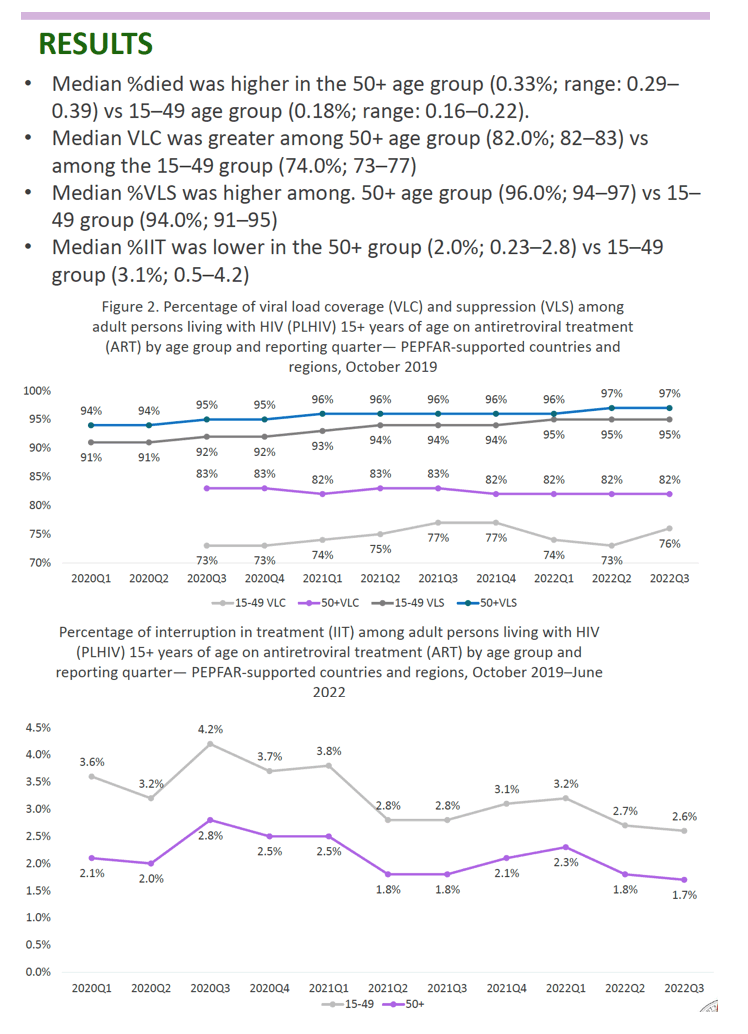
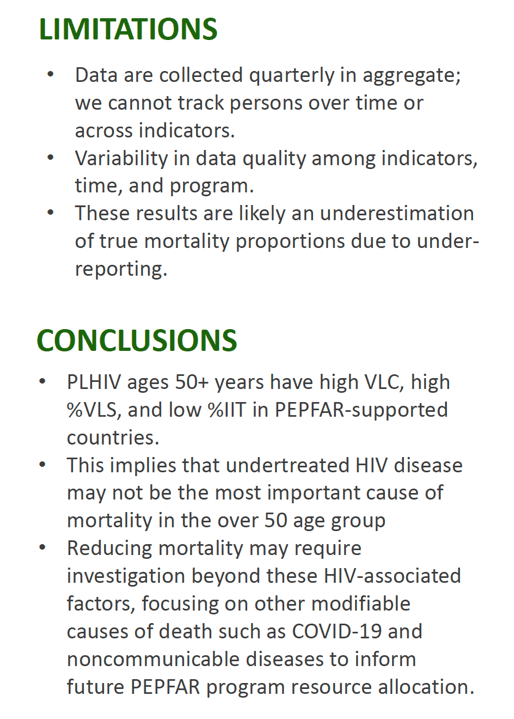
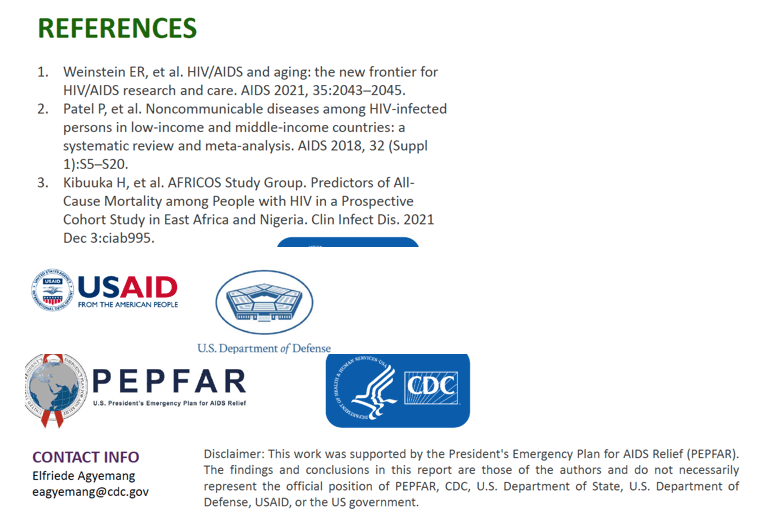
|
| |
|
 |
 |
|
|